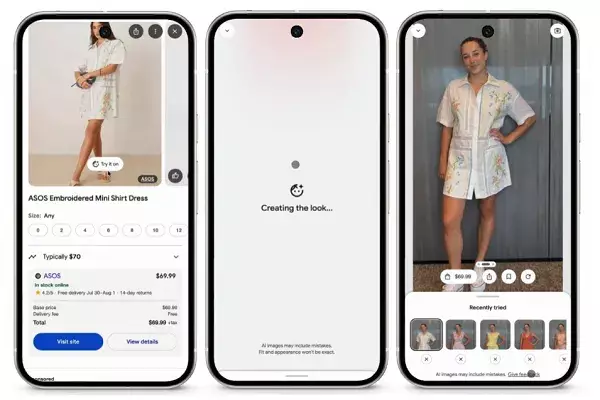In the evolving landscape of e-commerce, Google’s recent introduction of AI-driven virtual try-on features marks a pivotal shift toward creating a more personalized and immersive online shopping experience. The innovative use of selfie-based visualization allows consumers to see how clothing items might look on their own bodies, transcending the limitations of traditional product images. This move suggests a future where virtual fittings could replace physical trying in many cases, effectively bridging the gap between in-store and digital commerce. However, despite the promise, questions about accuracy and real-world resemblance still linger. The success of such technology hinges on how convincingly AI can mirror real-life appearances, and whether shoppers will trust these previews enough to make confident purchase decisions.
Yet, one must also be critical of potential shortcomings. AI try-on systems are only as good as their underlying data and algorithms, which means inaccuracies—like misaligned fits or unrealistic depictions—could frustrate users and undermine trust. Additionally, privacy concerns emerge when consumers upload their images for virtual try-ons, raising questions about data security and how these images are stored and used. While Google’s rollout is promising, the adoption of such technology on a broad scale will depend heavily on its reliability and how well it manages user trust.
Enhanced Price Tracking: Empowering Consumers in a Competitive Market
Another transformative feature Google is launching pertains to price alerts—an essential tool in today’s price-sensitive shopping environment. The upgraded price tracking system enables users to specify preferences such as size, color, and target price, while Google leverages its extensive Shopping Graph to monitor listings across the web. This feature promises to arm consumers with real-time intelligence, ensuring they don’t miss out on lucrative deals and discounts, especially during high-volume sales seasons.
However, the effectiveness of this feature depends on its ability to deliver timely and accurate notifications. Price fluctuations are often complex, influenced by multiple factors including stock levels and seasonal promotions. If Google’s alerts fail to keep pace or provide false positives, it could diminish their utility. Moreover, there’s a risk that users might become overly reliant on these alerts, potentially leading to impulsive purchasing that could strain budgets or result in regret if deals turn out less favorable than expected. Nonetheless, this development signifies a move toward more shopper empowerment, allowing for smarter, more informed purchasing decisions in a crowded online marketplace.
Refining Search with AI: The Shift to Natural Language and Visual Matching
Google’s latest advancements in search capabilities further demonstrate a commitment to aligning online shopping with how consumers think and communicate. The introduction of text-based search matching allows users to describe their desired styles or products conversationally, making search more intuitive. For example, a shopper can simply describe an outfit they envision, and Google’s AI will generate relevant results. This aligns with a broader trend of natural language processing, making digital searches feel less mechanical and more aligned with human communication.
Nonetheless, this innovation is not without its pitfalls. AI’s interpretative capabilities depend on the quality of training data and contextual understanding. Misinterpretations or overly broad results could lead to shopper frustration. As search algorithms become more complex, ensuring they remain transparent and reliable becomes more crucial. Moreover, while these advances work well for popular or straightforward queries, niche styles or unique preferences might still challenge the system’s effectiveness.
Furthermore, the integration of visual matching—allowing users to find products based on images—embodies a significant leap toward seamless discovery. This feature reduces the need for precise keyword input, making shopping more accessible and engaging. Yet, it also raises concerns about algorithmic biases and the potential for misuse, such as copyright infringement or misrepresentation of products.
Looking Forward: The Future of Personalized Digital Commerce
Google’s bold investments in AI-driven shopping tools underline an industry-wide recognition that personalized, intuitive, and smart shopping experiences are the future. These features are designed to make the digital marketplace more akin to physical stores, where expert staff and personalized service guide purchasing decisions. The challenge remains in perfecting these technologies to inspire genuine trust and engagement among users.
While critics might argue that these innovations risk commodifying privacy or creating an over-reliance on automated systems, it is undeniable that they hold the potential to revolutionize how consumers discover, evaluate, and purchase products online. As Google continues to refine and expand these tools, the ultimate test will be their ability to provide genuinely helpful, accurate, and trustworthy assistance that elevates the ordinary act of shopping into a truly personalized experience.

